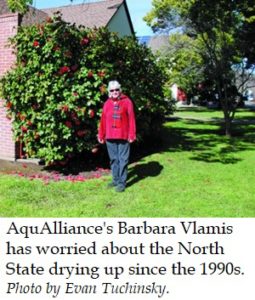By Jonas Minton, Special to The Sacramento Bee
February 5, 2019
 Despite many high priority issues on his plate, one of Gov. Gavin Newsom’s first tests will be how he deals with California’s water challenges and opportunities. Unfortunately, in the last days of his term Gov. Jerry Brown made a bad bargain with the Trump administration and special interests. It’s yet another mess for the new governor to mop up.
Despite many high priority issues on his plate, one of Gov. Gavin Newsom’s first tests will be how he deals with California’s water challenges and opportunities. Unfortunately, in the last days of his term Gov. Jerry Brown made a bad bargain with the Trump administration and special interests. It’s yet another mess for the new governor to mop up.
During his last month, Brown quietly signed an agreement with the Trump administration to transfer water from Southern California and portions of the Bay Area to corporate farms in the San Joaquin Valley. In return, the Trump administration dropped its threatened opposition to Brown’s legacy project — the massive tunnels that would divert water from the San Francisco Bay Delta. This was done with no public notice, hearing or environmental analysis.
Scientists have concluded that the effects of this closed-door deal are likely to cause the extinction of multiple California fish species. As a result, there are already over 20 lawsuits from water districts, farmers and environmentalists.
The deal helps saddle taxpayers and water users with billions of dollars of debt for tunnels whose costs estimates have already soared from $3 billion to $19.9 billion, not including interest. And that’s the estimate before securing right-of-ways or turning any shovels.
This massive debt would limit the state’s financial ability to ensure that disadvantaged communities get safe drinking water. The basic human right to water for hundreds of thousands of Californians would be kept in the back of the line behind Brown’s vanity tunnels project.
Now, the Trump administration and water special interests are pushing the new governor to go further and gut water quality protections for the Bay Delta and the state’s rivers from north of Redding all the way south to Bakersfield. After years of scientific study and countless hours of public input, the State Water Resources Control Board is poised to adopt standards that would protect these waters for all beneficial uses, including drinking, bathing, businesses, farming and the environment.
This requires careful balancing because water is not unlimited. Yet water special interests are now pressuring Gov. Newsom to replace the leadership on this state board that has maintained this careful balance.
Modern technology — including water recycling, stormwater capture, groundwater cleanup and improved water use efficiency —means Californians should continue to receive reliable supplies of highest quality water. In fact, many progressive water districts are already prudently investing in these 21st century solutions to provide reliable supplies of safe water to their customers.
No doubt Gov. Newsom would prefer to focus on other issues before having to deal with the water mess he inherited. However, the next two months will be critical for making key appointments and decisions.
At his inauguration, Gov. Newsom’s son, Dutch, symbolized our new governor’s tremendous responsibility to the future. Will he create a legacy of sustainable water management for all uses? Or will he preside over the extinction of species?
Click here to view article at sacbee.com.
The twin tunnels would take water from the Sacramento River and transport it under the Delta. See which islands and rivers they would cross. [By
Jonas Minton is senior water policy advisor at the Planning and Conservation League and former deputy director at the California Department of Water Resources.


 Food & Water Watch and Center for Food Safety served a lawsuit today to challenge the Metropolitan Water District of Southern California’s approval of $11 billion to fund the twin Delta Tunnels. The groups claim MWD’s financing violates the taxpayer protection provisions of California’s Constitution, enacted by voters in Propositions 26 and 13. MWD’s decision to pay for most of the massive tunnels project, while receiving only part of the project’s water, would result in its ratepayers and taxpayers unconstitutionally subsidizing out-of-district water users, including corporate agribusiness in Kern County.
Food & Water Watch and Center for Food Safety served a lawsuit today to challenge the Metropolitan Water District of Southern California’s approval of $11 billion to fund the twin Delta Tunnels. The groups claim MWD’s financing violates the taxpayer protection provisions of California’s Constitution, enacted by voters in Propositions 26 and 13. MWD’s decision to pay for most of the massive tunnels project, while receiving only part of the project’s water, would result in its ratepayers and taxpayers unconstitutionally subsidizing out-of-district water users, including corporate agribusiness in Kern County. By
By  the federal Bureau of Reclamation had just released an environmental review for a two-year water transfer—the process by which rights-holders to surface water (such as Sacramento River flow) can sell that water, with the option to meet their own needs via groundwater (underground flow, pumped through wells). She had just 10 days to submit comments.
the federal Bureau of Reclamation had just released an environmental review for a two-year water transfer—the process by which rights-holders to surface water (such as Sacramento River flow) can sell that water, with the option to meet their own needs via groundwater (underground flow, pumped through wells). She had just 10 days to submit comments. The federal district court in Fresno issued a strong order February 15, 2018 supporting many of the claims made by AquAlliance and co-plaintiff partners. The lawsuit was filed in May 2015 against the U.S. Bureau of Reclamation (USBR) and San Luis Delta Mendota Water Authority (SLDMWA) over their inadequate disclosure, avoidance of impacts, and mitigation of major water transfers from the Sacramento Valley through the Delta to the San Joaquin Valley.
The federal district court in Fresno issued a strong order February 15, 2018 supporting many of the claims made by AquAlliance and co-plaintiff partners. The lawsuit was filed in May 2015 against the U.S. Bureau of Reclamation (USBR) and San Luis Delta Mendota Water Authority (SLDMWA) over their inadequate disclosure, avoidance of impacts, and mitigation of major water transfers from the Sacramento Valley through the Delta to the San Joaquin Valley.